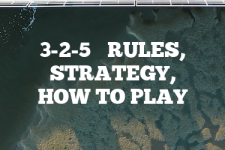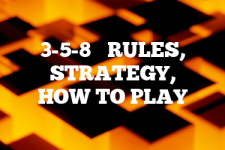Get good at Kaiserspiel – Rules, Strategy & Winning Instructions
This game is also known as KARNÖFFEL

Introduction
Kaiserspiel, whose name translates to “Emperor’s Game” in English, is another one in the family of German card games that we’ve explored previously. It’s a card game that requires a keen mind and strategic thinking. It’s played with a deck of 32 cards, which is a standard German deck, but you can also use a French deck if you remove the cards from 2 to 6.
You can play with 2, 4, 6, or 8 players, using a 48-card deck without Aces. When you have four or more players, they team up into two pairs of two players each. In the typical setup I’ll explain below, each player sits between an opponent on their left and another on their right. The dealing and gameplay always go in a clockwise direction.
Quick Tip for Kaiserspiel
Remember, in Kaiserspiel, the trump cards hold the power. Always keep an eye on them!
Rules for playing Kaiserspiel
- The game is played by four players in two teams of two.
- The ranking of the cards is as follows: Ace (also known as the Deuce), King, Ober, Unter, 10, 9, 8, 7.
- The aim of the game is to score points by taking tricks. The team with the most points at the end of the game wins.
The Deal for Kaiserspiel
The dealer shuffles the deck and deals eight cards to each player in batches of three, two, and three. The remaining cards are placed face down in the center of the table to form the talon.
The dealer begins by giving each player one card face up. The suit of the lowest-ranking card, or the first card of equally low rank if there are ties, becomes the trump suit. If only two players are involved, the dealer then provides a card face up to Forehand (the player on their left), and another to the second player, and then waits.
Forehand can suggest increasing the round’s value by 3 points, making it 7 points, and may discuss this with their partner(s). If Forehand suggests an increase, the second player can either accept it, surrender the round (in which case the proposing side scores 4 points), or propose another increase of 3 points, raising the value to 10 points.
If Forehand refuses, the proposing side wins a 7-point round, and the next round begins. If Forehand doesn’t make a proposal, the second player can do so. In the second and third rounds of dealing, each player gets two cards face down, with pauses for possible value increases after each pair of cards is dealt. When four people play, partners can privately show their cards to each other and discuss whether to propose or surrender.
With six or more players, each side appoints a director who can give advice on whether to propose, accept, or refuse an increase.
Interrupting the Deal
If, during the deal, the round’s value reaches a level where one side can win given their current score, someone from that side should announce this, and no further increases can be proposed. The exception is when one side is within 4 points of winning at the start of a deal; in this case, they are not required to draw attention to it but can keep proposing increases until their opponents realize the situation and announce it, preventing further increases. In a two-player game, each player can propose and decide on their own.
Cards and Players
- You can play with 2, 4, 6, or 8 people, using a 48-card pack without Aces. If there are four or more players, you form two teams of two, and each person sits between opponents. The cards are always passed to the left.
How to Play Kaiserspiel
- Setup: Players sit opposite their partner. The dealer is chosen at random. Draw cards to find out who will be partners and the first dealer. If there are more than two players, those who draw the lowest cards become partners, as do those who draw the highest. The person who draws the lowest card gets to deal first.
- Gameplay: The player to the left of the dealer leads the first trick. Players must follow suit if possible. If they cannot, they can play any card. The trick is won by the highest card of the suit led, or by the highest trump if any were played. In each round, players should try to win three out of the five tricks played. Forehand leads to the first trick with any card except the trump 7. The winner of each trick leads to the next. Play stops as soon as one side has won three tricks, and they score the value of the round set during the deal. There is no need to follow the suit of the first card played, and the highest card of the leading suit or the highest trump or special card, if any are played, wins the trick. In plain suits, the ranking order of cards is the same as when drawing cards (K, Q, J, 10, 9, 8, 7, 6, 5, 4, 3, 2).
- Scoring: Each team adds up the card points in their tricks. The Ace is worth 11 points, the 10 is worth 10 points, the King is worth 4 points, the Ober is worth 3 points, and the Unter is worth 2 points. It’s best, at the start, to decide on a goal score, which is usually one more than a multiple of 10, like 101. Each round is worth 4 points, but during dealing, each player can suggest increasing it by 3 points up to three times. If a suggestion is declined, the team refusing loses the points, and a new round begins with the next dealer. A special suit is chosen during dealing, and it’s ranked differently from the regular suits, as we’ll discuss later.
- End of the Game: The game ends when all tricks have been played. The team with the most points wins.
Regarding the trump suit, only three cards (J, 6, 2) are genuine trumps, and three cards (3, 4, 5) are partial trumps. The rest have no trumping power and can be seen as a fourth plain suit. Among trumps, they rank as follows:
- Karnöffel (J): Trumps everything.
- Pope (6): Trumps plain suits.
- Kaiser (2): Trumps plain suits.
- 3: Trumps plain suits but not Kings.
- 4: Trumps plain suits but not Kings or Queens.
- 5: Trumps plain suits but not Kings, Queens, or Jacks.
- K, Q, 10, 9, 8: Have no trumping power.
- The Devil (7): When led, it beats everything except Karnöffel, but if played from any other position, it always loses. Note: The Devil can’t be led as the first card to the first trick.
During the game, players can’t peek at each other’s cards. However, in a four-player game, each player will have seen their partner’s cards, and in six- and eight-player games, the director of each side will have seen their partners’ cards. In a four-player game, any player can advise their partner, and this advice must be given aloud for the opponents to hear. In the six- and eight-player games, the director can also advise their partners on which cards to play.
How to Win at Kaiserspiel
Winning at Kaiserspiel requires a good balance of strategy, teamwork, and a bit of luck. It’s important to communicate with your partner through your card play and to keep track of which cards have been played. Remember, the team that takes the most tricks will score the most points and win the game.
Best Strategies for playing Kaiserspiel
One of the best strategies in Kaiserspiel is to try to control the trump suit. If you and your partner can take the majority of the trump cards, you’ll have a strong advantage. It’s also beneficial to try to force your opponents to play their high cards early, leaving you in control in the later rounds.
1. Understanding the Game: The first step towards developing a strategy for Kaiserspiel is to understand the game’s rules. This includes knowing the card rankings, the point system, and the trick-taking process.
2. Memorizing: It’s important to remember which cards have been played and by whom. This will allow you to anticipate the cards that are likely to be played in the future, and therefore plan your moves accordingly.
3. Bidding Wisely: You should bid based on the strength of your hand. Don’t overbid or underbid, as both can lead to losing points. If you have a strong hand, bid high, but if your hand isn’t very strong, it’s better to bid low.
4. Communication with Partner: Since Kaiserspiel is a partnership game, effective communication with your partner is crucial. The best strategy is to play in a way that helps your partner and hinders your opponents.
5. Playing High Cards Early: It’s a good strategy to play your high cards early, especially if you think you can take the trick. This will ensure that you score points early and put pressure on your opponents.
6. Saving Trumps: Save your trump cards for later in the game when they can be used to win crucial tricks. However, don’t hold onto them for too long, as this could lead to wasted opportunities.
7. Observing Opponents: Pay attention to the cards your opponents play and how they play them. This can give you clues about their strategy and the cards they hold.
8. Leading with Lowest Card: If you are the first to play, it’s usually a good strategy to play your lowest card. This will give you a better idea of the cards your opponents have without risking too much.
9. Control the Game: Try to control the game by winning tricks when necessary and forcing your opponents to play certain cards. This will allow you to dictate the flow of the game.
10. Practice: Like any other game, the more you play Kaiserspiel, the better you’ll get at it. Practice will help you understand the game better and develop effective strategies.
Remember, every game is different and strategies should be flexible. Be ready to adapt your strategy based on the cards you’re dealt and how your opponents are playing.
Game Variations of Kaiserspiel
There are several variations of Kaiserspiel, including versions where the dealer can choose the trump suit, or versions where the number of cards dealt changes. These variations can add an extra layer of strategy and unpredictability to the game.
Scenarios for Kaiserspiel
There are many scenarios that can arise in a game of Kaiserspiel. You might find yourself with a hand full of trump cards, which could put you in a strong position. On the other hand, you might have a hand with no trumps and few high cards, which would require careful play and good teamwork to overcome.
Frequently Asked Questions about playing Kaiserspiel
What happens if I can’t follow suit? If you can’t follow suit, you can play any card.
How many points are needed to win? The game ends when all tricks have been played. The team with the most points wins.
Can I communicate with my partner? While you can’t directly communicate with your partner, you can signal to them through your card play.
What is the role of the dealer? The dealer shuffles and deals the cards, and plays last in each trick.
What happens if the cards run out? The game ends when all tricks have been played. If the cards run out before this, the remaining tricks are played without drawing new cards.
External Links
For more information on the cultural significance of Kaiserspiel and other traditional German card games, check out “Knüffeln, the Karnöffel of Frisia”, in The Playing-Card (Journal of the International Playing-Card Society, Vol 49 No 4, June 2021 by Paul Eaton

Eve Brownlee was a gamer before gaming communities on the internet were a thing. Eve grew up playing traditional, standard deck card games like Rummy and Bezique, taking an interest in the classics Backgammon and Chess. Parlor card games like Bridge continue to keep Eve active in the community. After a long career, primarily in horticulture for USDA in Maryland, Eve now travels and writes on The Pineapple (pineapples.info) and contributes to Quora/Pinterest topics. Contact Eve via email.



